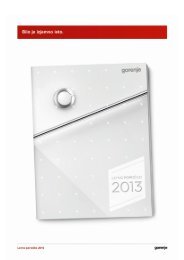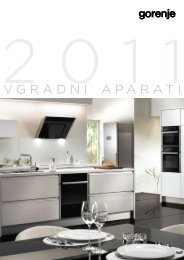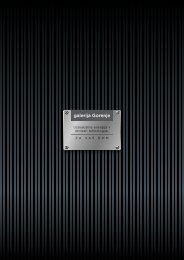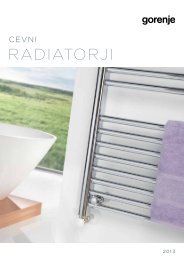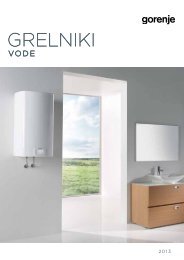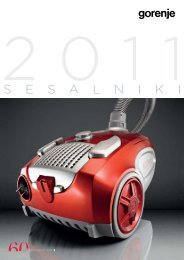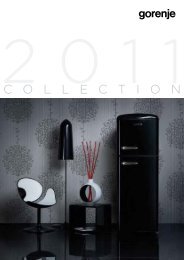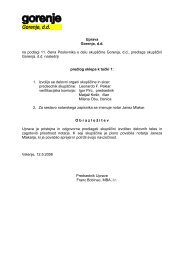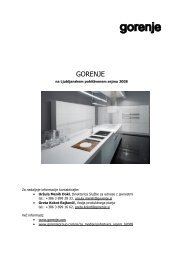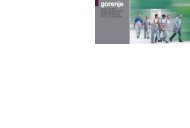ANNUAL REPORT 2008 - Gorenje Group
ANNUAL REPORT 2008 - Gorenje Group
ANNUAL REPORT 2008 - Gorenje Group
You also want an ePaper? Increase the reach of your titles
YUMPU automatically turns print PDFs into web optimized ePapers that Google loves.
146<br />
<strong>2008</strong><br />
ed use. Borrowing costs related to the development of qualifying assets are recognised in profit or<br />
loss as incurred. Other development expenditure is recognised in profit or loss as incurred.<br />
Capitalised development expenditure is measured at cost less accumulated amortisation and accumulated<br />
impairment losses.<br />
(iii) Other intangible assets<br />
Other intangible assets that are acquired by the Company, which have finite useful lives, are measured<br />
at cost less accumulated amortisation and accumulated impairment losses.<br />
(iv) Subsequent expenditure<br />
Subsequent expenditure is capitalised only when it increases the future economic benefits embodied<br />
in the specific asset to which it relates. All other expenditure, including expenditure on internally<br />
generated goodwill and brands, is recognised in profit or loss as incurred.<br />
(v) Amortisation<br />
Amortisation is recognised in profit or loss on a straight-line basis over the estimated useful lives<br />
of intangible assets, from the date that they are available for use. The estimated useful lives for the<br />
current and comparative periods are as follows:<br />
patents and trademarks<br />
capitalised development costs<br />
10 years<br />
10 years<br />
(f) Investment property<br />
Investment property is property held either to earn rental income or for capital appreciation or for<br />
both, but not for sale in the ordinary course of business, use in the production or supply of goods<br />
or services or for administrative purposes. Investment property is measured at fair value (see note<br />
4(iii)) with any change therein recognised in profit or loss.<br />
Property leased by the Company to subsidiaries for conducting activities is recorded within the<br />
item of property, plant and equipment. The item of investment property includes property, whose<br />
lease holders use more than 50% of available area.<br />
When the use of a property changes such that it is reclassified as property, plant and equipment,<br />
its fair value at the date of reclassification becomes its cost for subsequent accounting of depreciation.<br />
(g) Leased assets<br />
Leases in terms of which the Company assumes substantially all the risks and rewards of ownership<br />
are classified as finance leases. Upon initial recognition the leased asset is measured at an amount<br />
equal to the lower of its fair value and the present value of the minimum lease payments. Subsequent<br />
to initial recognition, the asset is accounted for in accordance with the accounting policy applicable<br />
to that asset.<br />
Other leases are operating leases. The leased assets are not recognised on the Company’s balance<br />
sheet.<br />
(h) Inventories<br />
Inventories are measured at the lower of cost and net realisable value. The cost of inventories of<br />
materials and merchandise is based on the weighted average price method and includes expenditure<br />
incurred in acquiring the inventories, production or conversion costs and other costs incurred<br />
in bringing them to their existing location and condition. In the case of manufactured inventories



